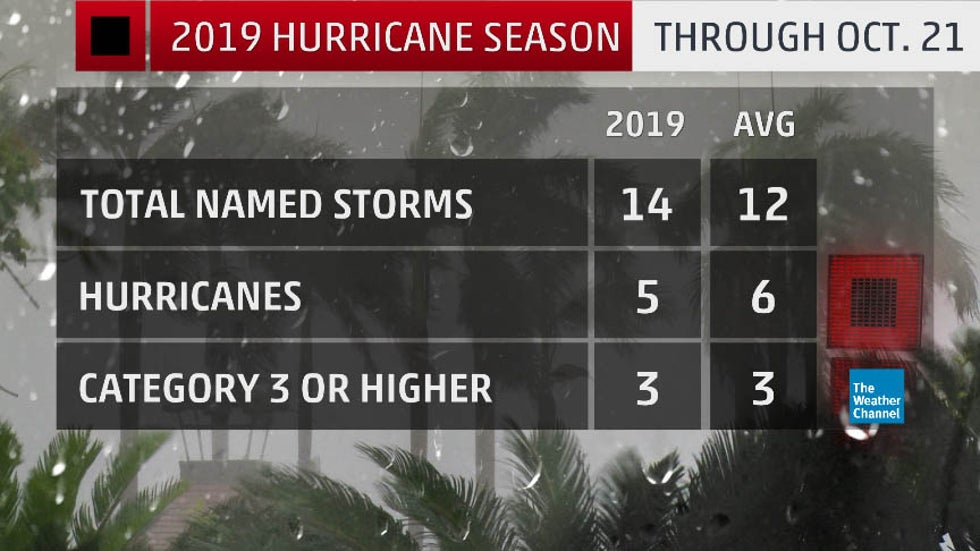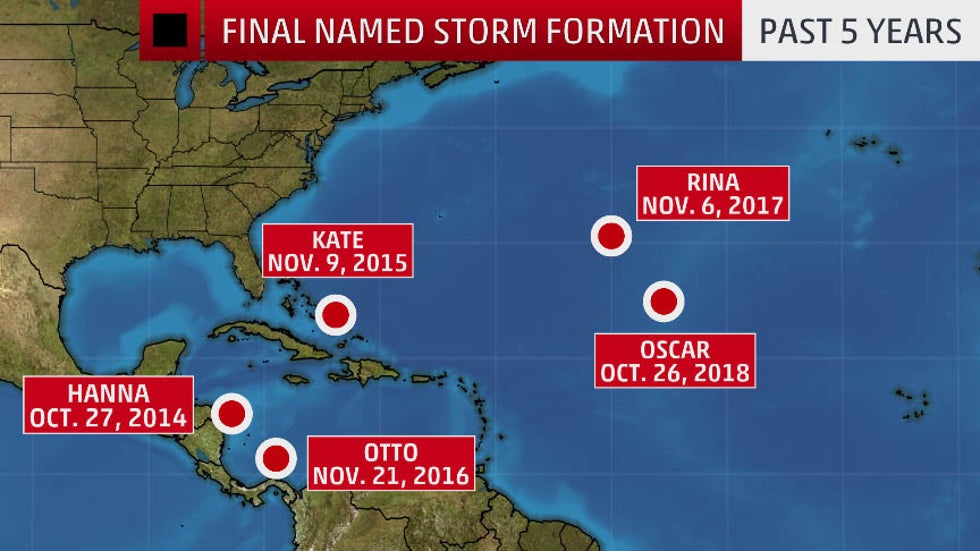Brian DoneganPublished: October 21, 2019

The Atlantic hurricane season has less than six weeks remaining, but as this past weekend's Tropical Storm Nestor shows, there is still life left in this season's tropics.
But how does this season compare to others? And what do other seasons show us about what's possible in the last six weeks and beyond?
Fourteen named storms have roamed the basin since the first storm, late May's Subtropical Storm Andrea.
Of those 14 named storms, five were hurricanes – Barry, Dorian, Humberto, Jerry and Lorenzo – and three were major (Category 3 or stronger) hurricanes – Dorian, Humberto and Lorenzo.
The 30-year average for a full season is 12 named storms, six hurricanes and three major hurricanes. The 14 named storms this season rank above average, but the five hurricanes are one below the 30-year average. The three major hurricanes are exactly average.

In an average year, one additional hurricane forms (1966-2009 average) before the end of the season on Nov. 30, according to the National Hurricane Center, so there's a chance the number of hurricanes could also end up exactly average.
Any post-season activity in December would be counted in this year's total, and any activity from January to May goes into the next year's total. The last five seasons have all had a named storm before June 1. The most recent tropical storm to develop after Nov. 30 was Olga in 2007.
NOAA's definition of an above average hurricane season has already been met. It classifies a season as above average if Accumulated Cyclone Energy (ACE) – which sums up all the named storms, how long they lasted and how strong they became – is greater than 120% of the median value (1981-2010) and two out of the following three are achieved: at least 13 named storms, seven hurricanes and three major hurricanes.
Although it is statistically above the long-term average, the 2019 Atlantic hurricane season has been slightly less active than the last several years when looking at the number of named storms. However, five of this year's storms had directly impacted the mainland United States – Barry, Dorian, Imelda, Melissa and Nestor – which is comparable to the last few hurricane seasons.
In 2018, 15 named storms, eight hurricanes and two major hurricanes tore through the Atlantic Basin. Four of the storms impacted the U.S., most notably hurricanes Florence and Michael within a month of each other.
2017 had the fifth-most named storms on record dating to 1851. There were 17 named storms that year, 10 of which became hurricanes and six of which intensified into major hurricanes.
Seven named storms impacted the U.S. in 2017. Most notably, hurricanes Harvey, Irma and Maria battered Texas, Florida and Puerto Rico, respectively.
The 2016 hurricane season was also active, with 15 named storms, seven hurricanes and four major hurricanes. Five named storms impacted the southeastern U.S. coast that year. The most notable of the bunch was Hurricane Matthew, with its powerful scraping of the coast and subsequent inland rainfall flooding.
When Does the Last Named Storm Form in a Typical Season?
Hurricane season officially runs through Nov. 30, but there is a decline in overall activity in the late part of the season.
In the last five years, the date of the final named Atlantic storm of the season has ranged from as early as the last week of October, to as late as Thanksgiving week.
A few seasons have ended exceptionally early – in late September or early October. As recently as 2006, the final named storm fizzled on Oct. 2.

But recent and long-term history show we cannot let our guard down yet.
The Atlantic has averaged one additional hurricane formation after Oct. 21 (1966-2009 average), according to the National Hurricane Center.
Last year, Hurricane Michael became the latest-in-season Category 5 hurricane to strike the U.S. when it made landfall on the Florida Panhandle on Oct. 10.
The latest a major (Category 3 or stronger) hurricane made landfall in the U.S. was the 1925 Tampa Bay hurricane on Oct. 25.
Hurricane Kate in 1985 is the latest-in-season hurricane landfall in the U.S. Kate came ashore at Mexico Beach, Florida, on Nov. 21, a week before Thanksgiving.
Sandy in 2012 is the most recent hurricane to make a late-season strike on the United States. Sandy transitioned into a non-tropical low-pressure system just before making landfall on the Jersey Shore on Oct. 29.
Roughly one-fifth of all U.S. hurricane landfalls have occurred in October and November, so residents along the Gulf and East coasts need to remain prepared.
On average, one hurricane forms every year in October, according to the National Hurricane Center. The most hurricanes to form in October was five in 2010.
By October, the formation zones of tropical storms and hurricanes typically shift westward toward the western Caribbean Sea, eastern Gulf of Mexico and far western Atlantic Ocean. In what is known as the "Cabo Verde" area, development of African easterly waves fades.
But in South Florida, October is the month with the most hurricane direct hits. According to NOAA's Best Track Database, 23 October hurricanes have passed within 100 nautical miles of downtown Miami since 1851.
Typical origins and tracks of tropical cyclones in October and November.
In November, the area to watch for tropical development shrinks significantly as upper-level winds turn increasingly hostile.
The southwestern Caribbean, however, can remain a hot spot for tropical development in November.
Most recently, Hurricane Otto formed in the southwestern Caribbean during the week of Thanksgiving in 2016. Otto then made landfall as a Category 3 on Thanksgiving Day in southern Nicaragua.
The Weather Company’s primary journalistic mission is to report on breaking weather news, the environment and the importance of science to our lives. This story does not necessarily represent the position of our parent company, IBM.
The Weather Company’s primary journalistic mission is to report on breaking weather news, the environment and the importance of science to our lives. This story does not necessarily represent the position of our parent company, IBM.

No comments:
Post a Comment